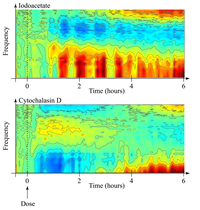Prof. David Nolte develops technology to see inside cancer cells
2011-02-10

A Purdue physicist has created technology to detect motion inside three-dimensional tumor spheroids, which may enhance the pharmaceutical industry's early drug discovery capabilities.
Physics professor David D. Nolte has developed Holographic Tissue Dynamics Spectroscopy (TDS), a technology that allows researchers to look inside cells using holography and lasers. The technology was highlighted in a letter of the peer-reviewed Journal of Biomedical Optics. The work is done in collaboration with John Turek, professor of basic medical sciences at Purdue.
"This technique measures the living motion that is going on inside a cell," Nolte said. "We're picking up the actual motion, all that activity going on inside the cell, and seeing how the cells are modifying their activities in response to applied drugs."
The first process used by Nolte's technology is holography, which shows a tumor tissue in three dimensions.
"Most drug development takes place in a two-dimensional environment, but there are differences in how cells respond to drugs in a three-dimensional environment," Nolte said. "My colleagues and I make digital holograms of the tumor, which can grow up to one millimeter in size. With this holographic technique with lasers, we see all the way through the tumor, not just the surface."